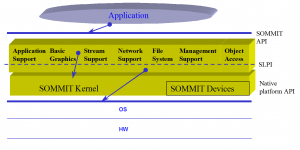| Previous chapter | Next section | Next chapter | |
| ToC | Works, Rights And Exploitation | Humans Interact With Machines | Digital Media Do More |
My encounter with IT as a (business) tool for the AV world happened towards the end of the MPEG-2 development and was greatly enhanced by my participation in the DAVIC work. Of course until the time I was doing research myself, I had been a good IT user, but only of computing services, i.e. as a tool to write video coding simulation programs and have it run to produce simulation results. But in my exposure to MPEG and DAVIC I saw how the creation of vertical solutions built on top of proprietary CPU’s and OS’s could not lead to the kind of transparent experience of digital AV applications and services that was the target for myself and, by reflection, DAVIC. This aspect was eventually addressed by DAVIC 1.0 specification with the adoption of MHEG-5, a computing platform-agnostic, purely declarative (i.e. not dependent on a computing environment) multimedia standard.
But something had to be done for the longer term. During the October 1994 HDTV Workshop in Turin I discussed the idea of a “full software” terminal with Marcel Annegarn of Philips, who had been one of the first members joining the HDTV Workshop Steering Committee, and received positive reactions. So motivated to proceed, I considered that such a project could only succeed if I could bring together a small number of major representatives in the CE, IT and telco spaces to an industrial initiative. As I used to say at that time, the goal could be achieved, if necessary, by bringing together the Devil and the Holy Water (Italian expression), without of course identifying which was the Devil and which was the Holy Water.
In December I had already established contacts, in addition to those already started with Philips, with France Telecom, IBM, Microsoft and Sony. A first meeting was convened at CSELT at the end of January 1995 and the decision made to submit a proposal to the next Call of the Advanced Communication Technologies and Services (ACTS) program of the CEC. The non-European companies were represented by their European research facilities but eventually Microsoft dropped out because at that time they did not have a significant European research force to mobilise.
The project was named Software Open Multi-Media Interactive Terminal (SOMMIT) and the goal stated in the proposal was
To define an open interactive multimedia terminal architecture, application and delivery media independent, that allows a full software implementation.
In the course of the project, the goal was made more precise with the following formulation
To provide an object-oriented library suitable to support the writing of the applications that implement multimedia services
that could be ported to different terminals.
A specific goal of the SOMMIT project was to provide an architecture that would allow source code portability both at the application level (i.e. the possibility of using the same application for different platforms, with different hardware and OSs) and at the library level (i.e. the possibility of porting the same SOMMIT libraries – on which applications rely – to different platforms). In Figure 1 the code located below the Software Library Portability Interface (SLPI) line was written in a way that portability to many environments was possible. The SOMMIT API (SAPI) was specified in IDL so that a SOMMIT application could be written using a standard high-level language such as C or C++ that could then be compiled for the target platform on which the SOMMIT library was present. The compilation ensured portability of the application through the generation of different versions of the binary code, one for each target platform. This approach allowed high performance and access to platform resources.
Fig. 1 – SOMMIT Library and Subsystems
The project implemented all software modules in the figure and worked hard to show a first demo. Unfortunately, this was achieved only a few months after the major CE companies, at least in Europe, had made up their minds about a solution that provided similar functionalities but at the cost of being dependent on a proprietary solution. The Multimedia Home Platform (MHP) specified by DVB did provide all functionalities that the SOMMIT solution would have offered. Its limited market take up had many causes, but one of them is the fact that it was highly antagonised by some quarters, and SPs and application developers stood at the window for some time and eventually turned their eyes elsewhere.
| Previous chapter | Next section | Next chapter | |
| ToC | Works, Rights And Exploitation | Humans Interact With Machines | Digital Media Do More |
